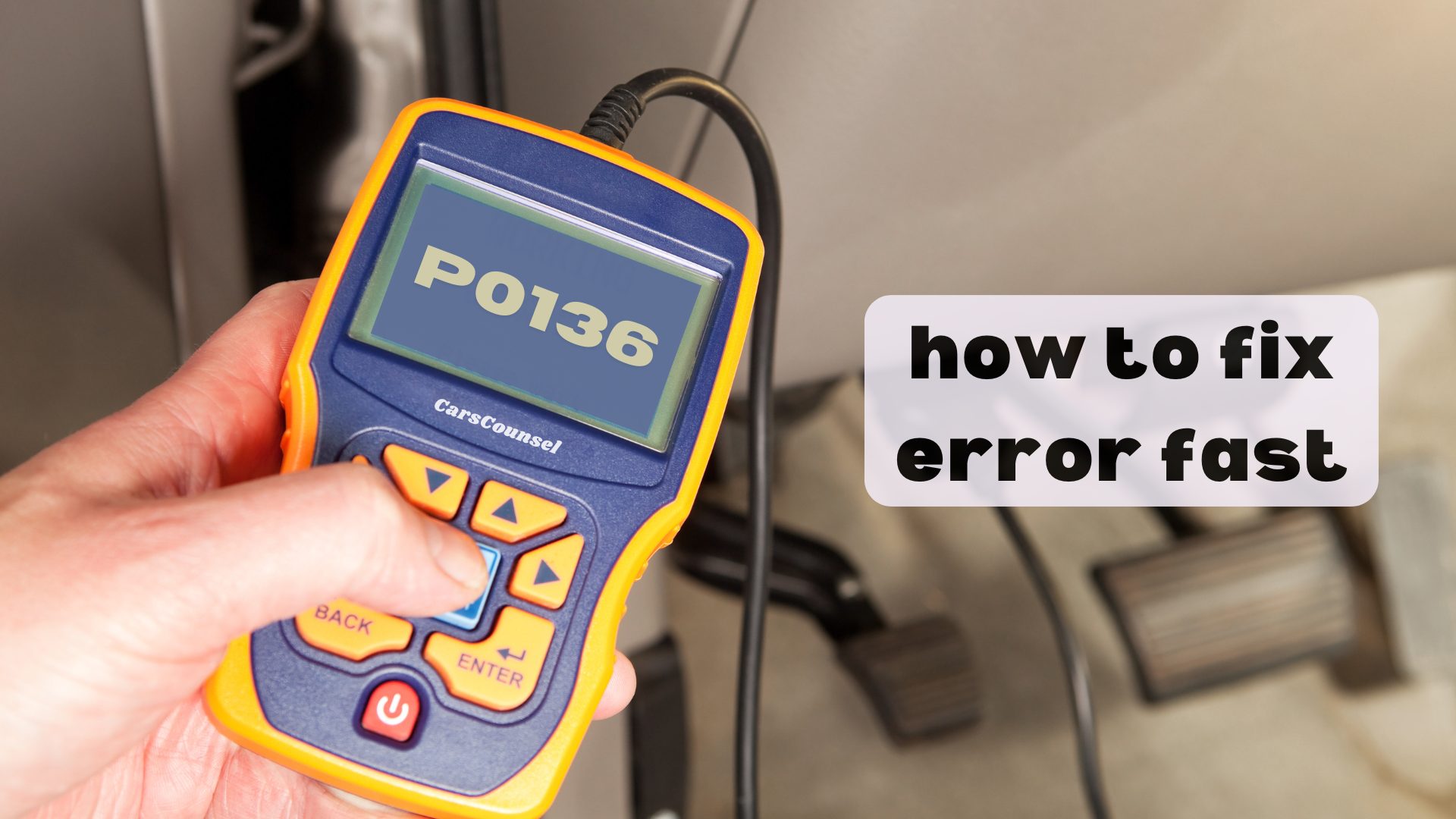What’s lurking beneath the hood of your vehicle, waiting to wreak havoc on your engine’s performance and your wallet? The P0136 code, that’s what.
This pesky error code indicates a malfunction in the Heated Oxygen Sensor Circuit for Bank 1 Sensor 2, which is responsible for monitoring oxygen levels in the exhaust gases. But what exactly is causing this malfunction, and how can you fix it before it’s too late?
The answers lie ahead, and understanding the underlying causes and symptoms of this code is vital to getting your vehicle running smoothly again.

Quick Navigation
Key Takeaways
- P0136 code indicates a problem with the Heated Oxygen Sensor (HO2S) Circuit for Bank 1 Sensor 2 in the exhaust system.
- The HO2S monitors oxygen levels in the exhaust gases, helping the engine control module (ECM) adjust the air-fuel mixture for peak combustion efficiency.
- Common causes of the malfunction include sensor failure, damaged wiring or connectors, contaminated sensors, faulty ECM, and other exhaust system issues.
- Symptoms of the P0136 code include decreased fuel efficiency, rough idling or stalling, engine misfires, and an illuminated Check Engine Light.
- Diagnosing and fixing the issue requires using an OBD-II scanner, inspecting wiring and connectors, and replacing the faulty sensor if necessary.
Code P0136 Description
When your vehicle’s onboard diagnostics (OBD-II) system throws a P0136 code, it indicates a problem with the Heated Oxygen Sensor (HO2S) Circuit for Bank 1 Sensor 2 in the exhaust system.
This sensor monitors oxygen levels in the exhaust gases, helping the engine control module (ECM) adjust the air-fuel mixture for peak combustion efficiency.
Bank 1 refers to the side of the engine where cylinder 1 is located, and Sensor 2 is the downstream sensor located after the catalytic converter.
The HO2S’s primary function is to monitor oxygen levels in the exhaust gases, providing vital data for the ECM to refine engine performance.
Understanding the sensor functions and their role in the exhaust system is essential for diagnosing and repairing the issue.
Causes of Heated Oxygen Sensor Malfunction
Since the Heated Oxygen Sensor (HO2S) plays a critical role in maintaining ideal engine performance, a malfunction can have significant consequences.
You’ll want to identify the root cause of the issue to prevent further damage to your vehicle’s engine.
Some common causes of Heated Oxygen Sensor malfunction include:
- Sensor Failure: A faulty HO2S can’t accurately monitor oxygen levels, leading to poor engine performance and decreased fuel efficiency.
- Damaged wiring or connectors: Corrosion or damage to the wiring or connectors can prevent the HO2S from sending accurate signals to the ECM.
- Contaminated sensor: Oil or coolant leaks can contaminate the sensor, causing it to malfunction and provide inaccurate oxygen level readings.
Symptoms of P0136 Code
If your vehicle’s onboard computer has stored a P0136 code, it’s likely that you’ll notice some performance issues.
You might experience decreased fuel efficiency, which can be frustrating and costly. Your engine’s performance will also suffer, leading to rough idling or stalling.
Additionally, you may notice engine misfires, which can cause your Check Engine Light to illuminate. In some cases, you might even fail an emissions test.
These symptoms can be a hassle, but they’re a clear indication that there’s a problem with your Heated Oxygen Sensor Circuit.
Diagnosing and Fixing P0136
You’ve received a P0136 code, and now it’s time to take action.
To diagnose and fix the issue, start by using an OBD-II scanner to confirm the code and identify the problem.
Next, inspect the wiring and connectors for any damage or corrosion, repairing or replacing as necessary.
- Perform Sensor Troubleshooting by testing the HO2S using a multimeter to check for proper operation or replace the sensor if faulty.
- Implement Fuel Efficiency Tips to optimize your vehicle’s performance and reduce emissions.
- Clear the code and drive the vehicle to verify the issue has been resolved.
If the problem persists, further diagnostics may be needed to identify any underlying ECM issues.
Replacing the Heated Oxygen Sensor
Replacing the faulty Heated Oxygen Sensor is a pivotal step in resolving the P0136 code issue.
You’ll need to purchase a replacement sensor that matches the original specifications. Before installation, inspect the wiring and connectors for any signs of damage or corrosion, and repair or replace them as necessary.
This wiring inspection is essential to guarantee proper sensor operation. When replacing the sensor, follow the manufacturer’s instructions and take necessary precautions to avoid damaging the surrounding components.
Properly connect the new sensor and then clear the P0136 code using an OBD-II scanner. Start the engine and monitor the sensor’s operation to guarantee its correct operation.
Repair Cost and Additional Info
After replacing the Heated Oxygen Sensor, you may be wondering about the cost of resolving the P0136 code issue.
The cost of repairing a Heated Oxygen Sensor Circuit Malfunction can vary depending on the make and model of your vehicle.
- Parts can range from $50 to $200, while labor costs can add another $100 to $200.
- Additional diagnostics or repairs may increase the overall cost.
It’s recommended to consult with a professional mechanic for a more accurate estimate based on your vehicle specifics.
Common P0136 Code Mistakes
When diagnosing and fixing the P0136 code, crucial steps can be overlooked, or symptoms can be misinterpreted, leading to prolonged repair times and costly mistakes.
One common mistake is sensor confusion, where you misidentify the faulty sensor or replace the wrong one. Make sure you’re addressing the correct Bank 1 Sensor 2.
Additionally, DIY dangers lurk when attempting to repair the issue without proper knowledge or tools. You may damage the sensor or surrounding components, leading to further complications.
Be cautious when working with electrical systems and consider seeking professional help if you’re unsure.
Professional Repair Recommendations
Get a professional mechanic on board to guarantee a thorough diagnosis and repair of the P0136 code, especially if you’re not familiar with the intricacies of the Heated Oxygen Sensor Circuit.
Their expert insights will help you avoid common mistakes and certify a proper fix.
With their guidance, you’ll get:
- Accurate diagnosis and identification of the root cause of the problem
- Expert repair techniques and Diagnostic Tips to verify a thorough fix
- Access to specialized tools and equipment necessary for the repair
More OBD-II Codes
Frequently Asked Questions
Can a Faulty HO2S Cause Damage to the Catalytic Converter?
You’re wondering if a faulty HO2S can cause damage to the catalytic converter. Yes, it can; sensor failure can lead to rich fuel mixtures, increasing converter temperatures and potentially causing converter damage.
Will a P0136 Code Trigger a Check Engine Light on the First Occurrence?
You’ll likely notice the Check Engine Light (CEL) on the first occurrence of a Sensor Failure or Oxygen Malfunction, as the onboard computer detects the issue and triggers the warning to alert you to the problem that needs attention.
Can Low Fuel Pressure Contribute to a P0136 Code?
As you navigate the complex highway of engine performance, a low fuel pressure issue can be a hidden roadblock, causing your fuel injector to stumble, which may, in turn, trigger a P0136 code, highlighting the delicate balance between fuel delivery and oxygen sensor function.
Do All Vehicles Have a Bank 1 Sensor 2 HO2S Location?
You’ll find that not all vehicles have a Bank 1 Sensor 2 HO2S location, as sensor placement varies depending on engine design and manufacturer specifications, with some engines having a single sensor or different sensor configurations.
Will a P0136 Code Always Cause Noticeable Drivability Issues?
You won’t always notice drivability issues with a P0136 code, as it depends on the severity of the sensor failure. If oxygen levels are only slightly off, you might not experience noticeable problems, but decreased fuel efficiency and engine performance are likely.
Conclusion
You’ve made it to the end of this wild ride, and now you’re armed with the knowledge to tackle that pesky P0136 code! Don’t let a faulty Heated Oxygen Sensor turn your engine into a gas-guzzling, emissions-spewing monster – take control and fix it! With the right tools and a bit of know-how, you’ll be back on the road in no time, with a purring engine and a clear conscience.

